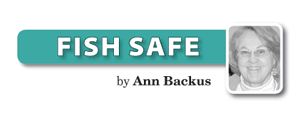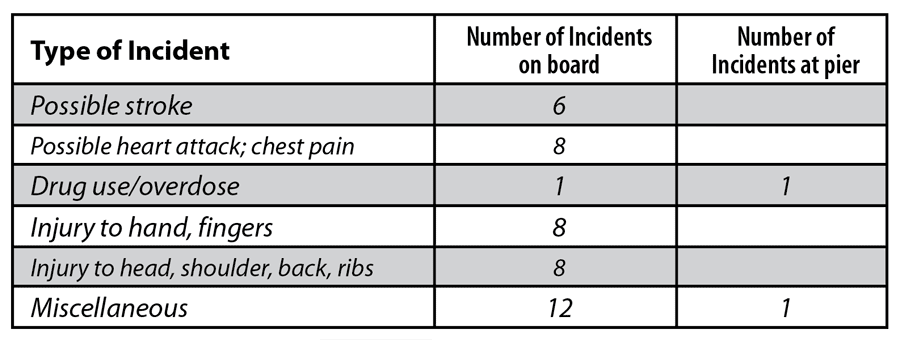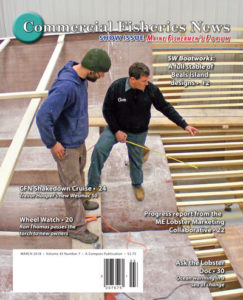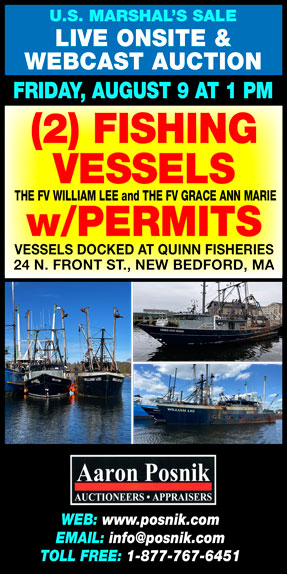Sinkings, fires, dewatering, collisions, allisions – Coast Guard personnel respond to many different types of emergency calls.
As we all know, in addition to these vessel-related calls, the Coast Guard responds to many crew-related calls as well.
When a crewmember or captain is injured or not well, a mayday call can result in either a medico or medevac response.
A medico response often results in advice to the captain and the decision to return to port, while a medevac obviously signifies  evacuation of an injured or ill victim from the fishing vessel.
evacuation of an injured or ill victim from the fishing vessel.
For the purpose of this article, we’ll analyze the Coast Guard District 1’s 2017 casualty database, first by type of response as coded in the database, then by type of incident.
Type of response
In 2017 there were a total of 43 medico and medevac responses. Five additional casualties were recorded as “death.”
The medico responses were generally of a less serious nature. Of the 14 Medico responses there were two possible strokes, one heart or chest pain-related incident, two shoulder or back injuries, and eight miscellaneous illness complaints.
There were 29, or slightly more than twice as many, medevac responses as medicos.
Of these, four were possible strokes, seven were heart or chest pains, eight were injured hands or fingers, six were head or back injuries, and four were miscellaneous illnesses. Three of these 29 resulted in death.
In 2017 there were a total of eight deaths in District 1, three of these were fishing-related and two occurred at the pier.
Type of incident
The accompanying table shows a break-out of the types of incidents – as in, the reason the Coast Guard was called to help.
Not counting the miscellaneous category, 16 incidents were not fishing-related, and 16 were fishing-related.
Including the 8 deaths, 14 of these 49 casualties resulted in transfer to EMS personnel and 21 were listed as hospitalization. Seven returned to port. The remaining seven were a combination of unknown, overboard, at pier, and taken into custody.
Implications for captains, crew
What do these numbers suggest in terms of preparedness and prevention?
 The number of strokes and cardiovascular incidents undoubtedly reflects the “graying of the fleet.”
The number of strokes and cardiovascular incidents undoubtedly reflects the “graying of the fleet.”
While we may well have concerns related to the sustainability of fish resources, we also have concerns regarding the sustainability of the human resource in the fishing industry.
Can we interest enough younger people in fishing to sustain the industry as a viable economic sector?
The numbers also make a very strong case for the importance of first aid and CPR training for fishermen.
The ability to recognize the symptoms of stroke and heart attack often determines whether the victim lives or dies.
Rapid administration of baby aspirin (81 milligrams) to a heart attack victim, for example, can also make a large difference in the recovery trajectory – and perhaps confer as much as a 23% greater chance of surviving a heart attack.
The ability to respond quickly to an injury such as a severed hand or severed fingers by stopping the bleeding and saving a body part (not on ice) may also make a difference in the degree of future disability.
Updating first aid/CPR training and the contents of your first aid kit is a good idea. Be sure to include the baby aspirin.
If you have read this column over the years, you know that I suggest that every crewmember provide the captain with a sealed envelope which contains contact information for a land-based relative or friend and health information that would be pertinent in the event of a medical emergency.
Examples of health information are:
• Having diabetes;
• Taking insulin;
• On heart medicines and/or blood thinners and
• Epilepsy, pacemaker, etc.
This sealed envelope would be given to the medico or medevac team should an evacuation be necessary.
High on the list of all of us fishing safety folks is the drill instructor training course.
This comprehensive training provides fishermen not only with the credentials and tools to carry-out the mandated on-board drills, but provides hands-on practice in life-like simulations of common emergencies.
Sign-up and run on-board drills frequently; you may save a life.
In terms of prevention, the hazards of fishing are many.
Many injuries this past year were the result of contact with gear such as a winch drum, cable or dredge, or the result of a slippery, unsteady work platform.
In the case of contact with gear, constant reinforcement of safe handling of gear is very important. Proper training of new deckhands and sternmen is critical, as well.
Ann Backus, MS, is the director of outreach for the Harvard School of Public Health’s Department of Environmental Health in Boston, MA. She may be reached by phone at (617) 432-3327 or by e-mail at <abackus@hsph.harvard.edu>.

To get these complete stories and much more, you’ll need to purchase the MARCH 2018 issue of Commercial Fisheries News.
Please choose from the following options:
• BUY a Single PRINT edition of CFN that is delivered by MAIL. PRINT EDITION
• Quickly enjoy ONLINE access with our Hi-DEF flip-book. PURCHASE THIS ONLINE EDITION
• Shop the Online ARCHIVE
(Read online flip-book immediately with purchased access key and download a copy for yourself to keep. Not sure if it works for you? Try a FREE SAMPLE HERE.)
• SAVE BIG when you SUBSCRIBE!







